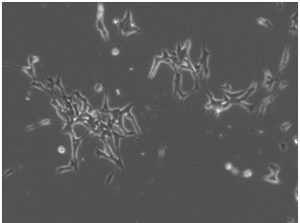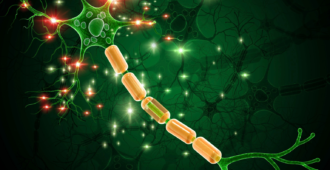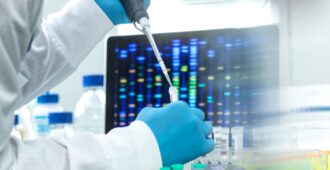Following on from baking, and understanding the roles of genes and proteins, Helena Chaytow (Royal Holloway) explains about her research. Helena is an MND Association-funded PhD student developing small strands of DNA, known as ‘antisense oligonucleotides’ to make motor neurones more resistant to damage.
DNA and RNA
The challenge of working with Motor Neuron Disease (MND) is that we don’t completely understand its causes. There are multiple theories for different events within cells that finally end up with the motor neuron-specific cell death found in MND. One of these theories relates to processing of RNA molecules, which are the cell’s method of communicating information from DNA with the rest of the cell. Find out more about DNA and RNA here.
Cell culture
My Ph.D., based at the Royal Holloway University, is looking into altering specific RNA processing events using short fragments of synthetic DNA. At the moment the treatment is at a very early stage; I’m testing the treatments I design on cell cultures. Cell culture is one of the workhorses of molecular biology, and involves growing cells in the laboratory. These cells act as a model for multiple diseases in laboratories around the world. They allow us to easily test new treatments on cells, often which have come from a human patient, and look at their effect on cell behaviour, gene expression or viability of the cell.
Above is an image of what cells look like in culture (under a microscope, obviously). These cells have come from a human neuroblastoma, a form of cancer that affects developing neurons in children. The characteristics that make cancer cells so dangerous to us are what make them extremely useful in laboratory conditions. Cancer cells are normal cells in the body which have had their reproduction capabilities switched into overdrive. They continue to replicate even when taken out of the body and placed in a plastic flask. Given the right “food” and enough space to grow, these cells can be grown in laboratories for weeks, allowing multiple treatments to be tested on human cells without the danger of these new drugs actually being given to humans.
My PhD
Through treating these cells with the synthetic DNA that I have designed, I can then analyse the effect on the RNA processing events within these cells. I have two aims: first to try and mimic the changes in RNA processing found in MND and second to try and improve the processing event with potentially therapeutic value. If I can mimic the changes in RNA processing using synthetic DNA, this would provide a simple cell model for MND that can be used for further testing of other treatments. Although this would be of interest to the scientific community, the most exciting outcome of my Ph.D. would be to find a way to reverse the changes in RNA processing. A lofty aim, but this was the outcome that inspired me to start the Ph.D. nearly two years ago. Information taken from how these tiny cells respond to our new treatments will be the key to future medicine in the years to come, and I’m excited to be part of the process.







Thank you for describing your research – and good luck.